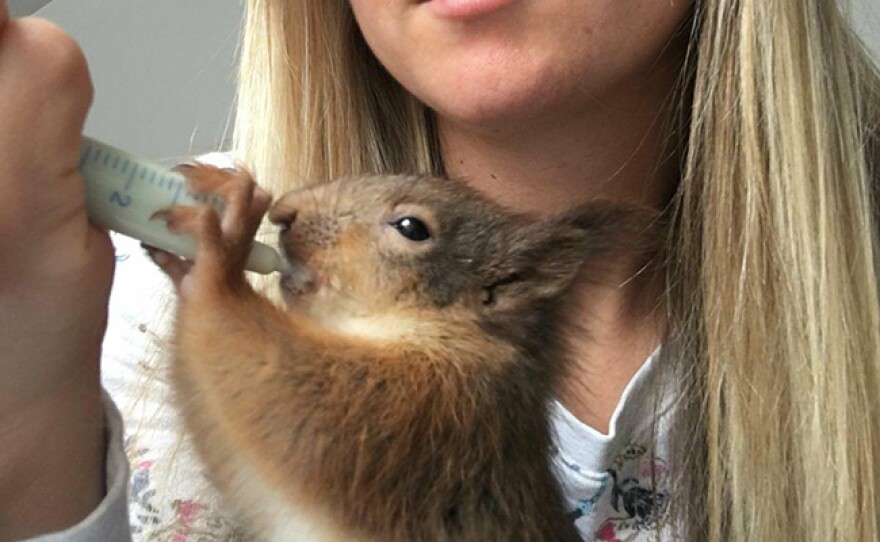Sunday, April 3, 2022 at 8 p.m. on KPBS 2 + Thursday, April 7 at 7 p.m. on KPBS 2 / On Demand
From tiny chipmunks to big prairie dogs, the squirrel family is one of the most widespread on Earth. There are almost 300 species of squirrels that can glide through the air, outwit rattlesnakes and survive the coldest temperatures of any mammal. What is the secret to their success? Uncover the extraordinary abilities of these cheeky nut lovers as a filmmaker puts their problem-solving to the test on a specially designed obstacle course.
On "A Squirrel's Guide To Success," join some of the world’s top squirrel scientists who are making groundbreaking discoveries — from the brainy fox squirrel who can remember the location of 9,000 nuts — to the acrobatic gray squirrel whose tree-top leaps are the basis for new designs in robotics. See the world through the eyes of an orphan red squirrel called Billy as he grows up and develops all the skills he will need to be released back into the wild.

Featured Species:
- Eurasian red squirrel
- Gray squirrel
- California ground squirrel
- Eastern chipmunk
- Arctic ground squirrel
- Prairie dog
- Jungle-striped squirrel
- Malabar giant squirrel
- Japanese flying squirrel
- Northern flying squirrel
- Fox squirrel
Noteworthy Facts:
- There are nearly 300 species of squirrels in the world, living in a huge range of habitats, from the forest canopy to the Arctic tundra to the baking desert.
- In the UK, the red squirrel population has plummeted by 95 percent. Seventy-five percent of the remaining red squirrels are found in Scotland.
- More than three feet long in size, the Malabar giant squirrel can hang upside down while they feed and use their grip to run down trees headfirst. An unusually flexible ankle joint allows their feet to rotate almost 180 degrees.
- A squirrel’s front teeth never stop growing to counteract the wear from a lifetime of relentless chomping.
- To survive the frigid winters in Alaska, the Arctic ground squirrel hibernates by dropping its heart rate, breathing and body temperature and survives on stored fat alone. Every two to three weeks the squirrel will shiver to warm itself.
- Squirrels are extraordinary leapers who can leap about 8-10 body lengths. Dr. Greg Byrnes, who has spent the last four years tracking squirrel’s movements in his lab at Siena College, learns that a squirrel’s leaping ability comes from their large leg muscles that act like an elastic band. To minimize the impact, they land with all four
- limbs on the ground at the same time.
- The Northern flying squirrel is just six inches long and weighs the same as a typical
- smartphone. Yet, it can leap almost 150 feet between trees at speeds of up to 20 miles per hour. Its “wings,” a membrane that stretches between its wrists and ankles, and another smaller membrane between the ankles and tail, allow it to glide through the canopy. A piece of cartilage on the end of the “wing” gives them an upturned tip, which reduces drag and increases stability (many airplanes have upturned tips on their wings for the same reason).
WATCH ON YOUR SCHEDULE:
This full episode is available on demand for a limited time. Extend your viewing window with KPBS Passport, a benefit for members supporting KPBS at $60 or more yearly, using your computer, smartphone, tablet, Roku, AppleTV, Amazon Fire or Chromecast. Learn how to activate your benefit now.
With the PBS Video App, you can watch your favorite and local station shows. Download it for free on your favorite device. The app allows you to catch up on recent episodes and discover award-winning shows.
JOIN THE CONVERSATION:
NATURE is on Facebook + follow @PBSNature on Twitter #NaturePBS
CREDITS:
NATURE is a production of THIRTEEN PRODUCTIONS LLC for WNET and PBS. For NATURE, Fred Kaufman is Executive Producer. Bill Murphy is series producer and Janet Hess is series editor. “A Squirrel’s Guide to Success” is a co-production of THIRTEEN PRODUCTIONS LLC and BBC Studios in association with WNET. The documentary is produced by Tom Jarvis and Gillian Taylor. Directed by Tom Jarvis and Rowan Crawford. Edited by Ross McFall. Cinematography by George Woodcock. Researched by Douglas Parker. Narrated by Ana Gasteyer. For BBC, Roger Webb is series editor and Holly Spearing is series producer.





